Not everything will go according to plan on the shop floor. That’s just a fact of life that you have to deal with — like how Snapple discontinued their glass bottles.
But to maintain steady production and good relationships with your customers, you need a reliable production schedule.
In the past, a notebook, checklists, and thorough daily inspections and interviews were the only way to control the production schedule.
While new digital tools have made this process a lot easier, it can be hard to set up the right platform.
In this article, we’ll cover what a production schedule is, common production strategies, pitfalls to watch out for, and how to effectively manage one in 2021.
What is a production schedule in manufacturing?
In manufacturing, a production schedule is a timeline set up to create the right amount of products to meet the demand within a timeframe. It helps you keep your costs low and avoid overproduction while still meeting your deadlines.
For a manufacturer, a solid production schedule is the foundation of a healthy customer relationship.
Note: The term production schedule is also used in video production, but that’s not what we’ll cover in this post. We’ll focus on the production of physical products.
What does a production schedule include?
A production schedule includes the necessary inputs and outputs, like raw materials, labor, routing, and more.
It covers the expected demand and the process of sourcing and turning enough raw materials into products during a limited timeframe.
A basic high-level overview might look something like this:
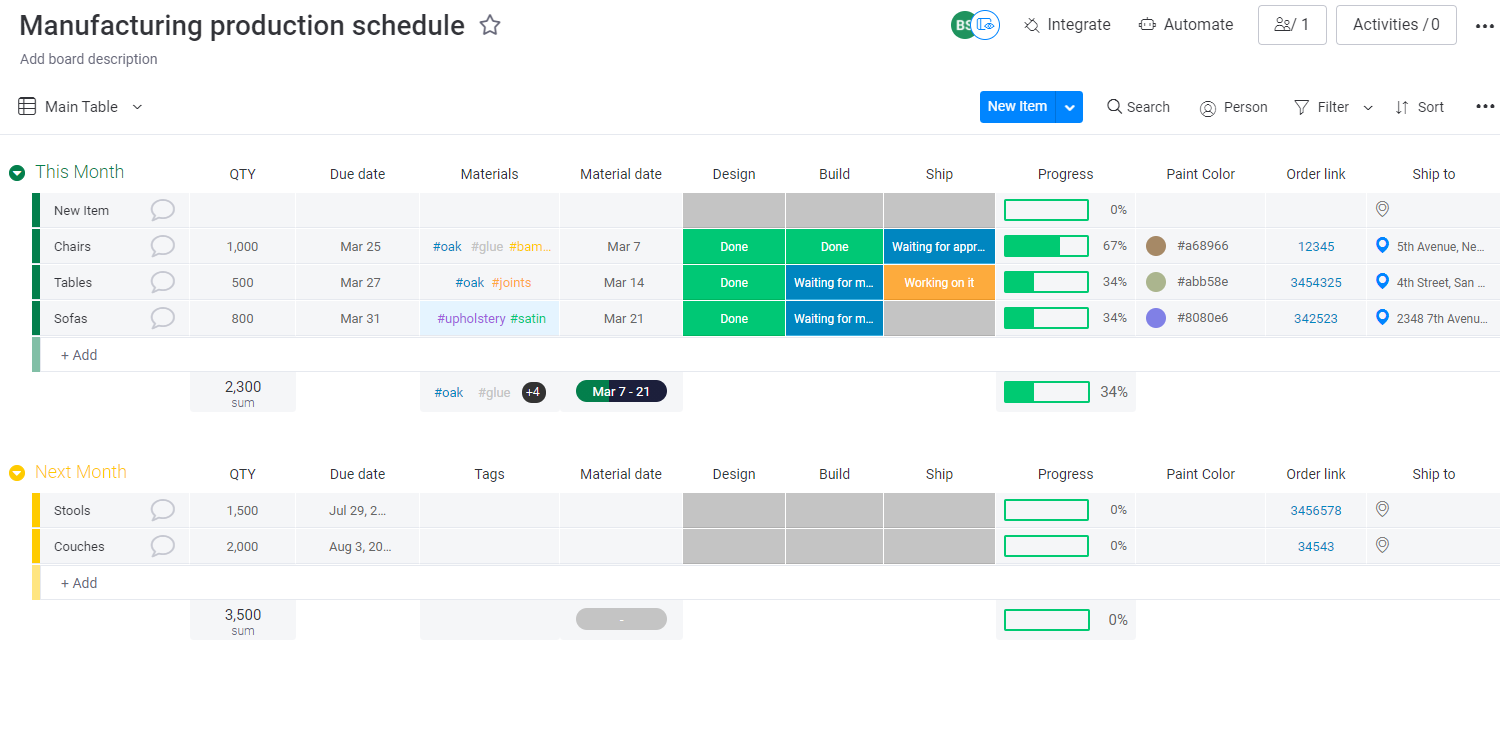
But you’d also need to plan out quantities of raw materials, timelines for supplier deliveries, and more. Tailor the master production schedule to your company’s unique process.
In production scheduling, you can’t just copy and paste a template and celebrate a job well done. You must make sure that it outlines all the moving parts in your production process.
To keep track of everything, teams often divide a master production schedule into 5 stages.
- Planning: estimating the number of products to make based on previous demand in similar periods or standing orders
- Routing: mapping out the path from raw material to finished product
- Scheduling: setting deadlines, assigning workers, and making purchasing decisions to meet the demand outlined in the planning phase
- Dispatching: assigning the tasks outlined in the previous phases in a way that makes sense in the current circumstances
- Execution: putting the plan into practice.
If you only cover production planning, routing, and scheduling with no system for dispatching or execution, your plan is limited.
Standardizing these processes and having fail-safes in place is crucial to stable production and sturdy customer relationships.
But the first stage of production planning is crucial. It sets the tone for all the following elements of the schedule and implementation. After all, producing 1,000 units and 10,000 units is a different ball game.
That’s why your planning approach is so important.
What are the basic production planning strategies?
Some of the most common strategies are level production, make-to-stock, and assemble-to-order. (There’s also the chase strategy, but we don’t recommend it.)
- Level production: you keep your production output fixed over time. It’s the easiest to manage logistically but can quickly lead to over or underproduction. Consumer demand fluctuates, so you need large safety stores and a large buffer to meet targets consistently.
- Make-to-stock: you make enough products to fill the shelves of your retailers. It’s not ideal for slower supply chains, as you need a 100%-perfect customer demand forecast.
- Assemble-to-order: you only make the exact amount of production orders from your customers. Very common with perishable products, like finished food dishes. But it’s growing in popularity as a part of the Lean manufacturing movement, too.
- Chase strategy: you try to predict and match the demand at any given time. The goal is to carry as few leftover products as possible. It’s hard to implement in rapidly growing or changing markets.
You can also categorize these even broader into push (expect demand) and pull (make only after orders).
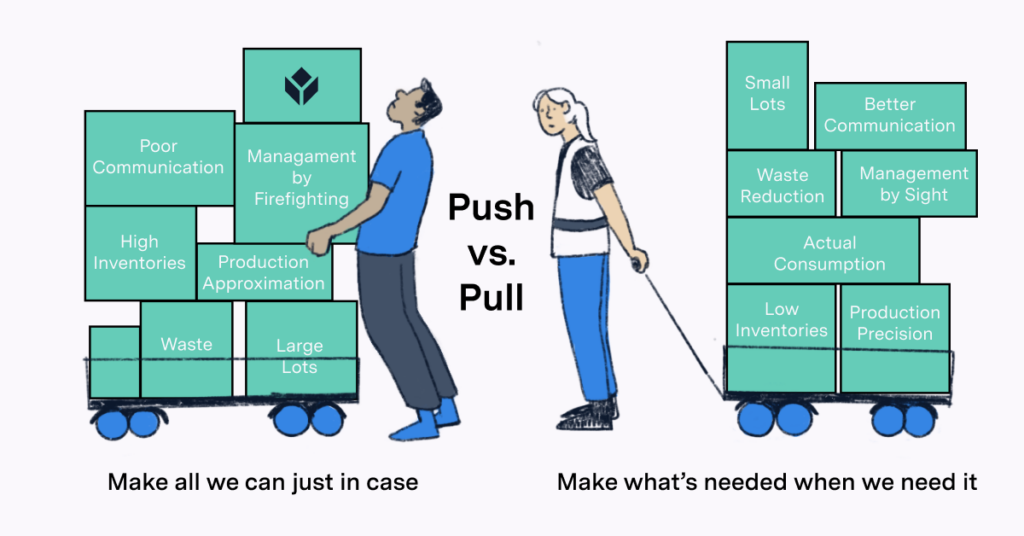
The epitome of the push approach is level production. On the other side of the spectrum, make-to-order is the best example of pull.
The upside of a push approach is that you have more leftover inventory during a crisis. But most companies avoid this approach because of high overhead costs and a much slower cash flow.
You also may not store all the products in a way where your supply will truly last much longer. Unforeseen fluctuations in demand can mean that you need to change your priorities.
A company that’s used to a static production plan will often struggle to adjust.
Next up, we’ll explore some of the most common issues with production scheduling.
Common production schedule pitfalls
Some of the most common pitfalls include too much faith in your supply chain and over or understocking.
Let’s take a closer look.
Thinking that the supply chain is infallible
No supply chain is immune to disruptions. The biggest mistake companies make is to assume that they don’t need a plan B — or even C — in place.The global lockdowns in 2020 proved how fragile most companies’ supply chains are. But even in the non-pandemic year of 2019, there were 1,000s of supply chain disruptions that impacted US businesses.
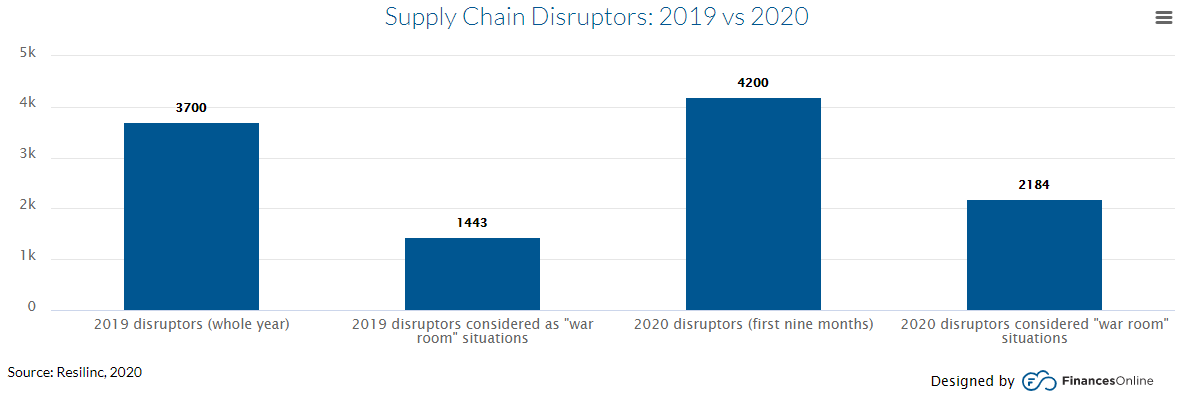
The outcome of a disruption can be devastating:
- Delayed shipments can damage or destroy customer relationships.
- Supplier bankruptcies can disrupt your entire business.
- Ordering raw materials, vehicles, or services last minute is a lot more expensive.
- Lasting brand damage can cost you new customers for years to come.
To solve this problem, supply chain leaders are focusing on resilience. They’re increasing their number of suppliers and focusing more on local or regional supply chains.
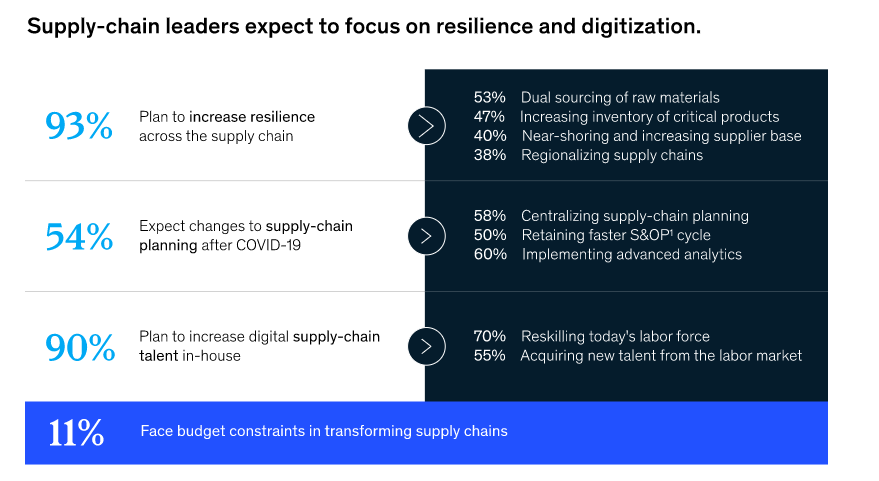
Improving robustness is a core principle of good supply chain management.
Keeping too much or too little safety stock
If the production process takes a long time, the last thing you want is to keep your customers waiting.
Can you handle a few days less production if a supplier’s shipment is late? Do you have a stock buffer? If your answer is “no” to both, you’re asking for a disruption.
But on the other hand, having too much stock hanging around isn’t good, either. You effectively slow down your cash flow and ability to invest in other products and projects.
So, calculate the ideal safety stock based on average delivery issues and the demand cycle.
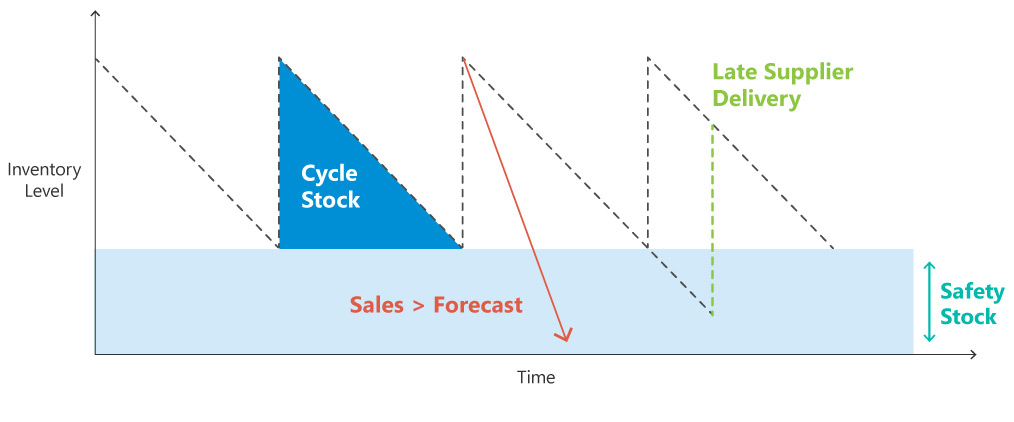
You also need a bare minimum of excess supply and materials to handle return requests at an acceptable rate.
Miscalculating when you’ll need the materials
You must know when in the manufacturing process you need each raw material in what quantities.
If you miscalculate when you need some materials in the production process, that’s it. Production has to pause or pivot to another product until it arrives.
The cost of unplanned downtime varies based on your company size and industry. In oil and gas, the average cost of unplanned downtime was $5 million last year.
Make sure that you don’t fall victim to these basic pitfalls when creating your production schedules.
How to manage your production schedule with monday.com
monday.com’s wide range of native integrations and extensibility through our automation builder and application programming interface (API) can help you modernize your production workflow.
You can use our robust platform to build the exact production scheduling software your company needs. Get more work done and avoid mistakes with all the information you need in one place.
Read also: CRM feature guide for manufacturing
Create a custom production schedule using our templates.
monday.com offers a basic manufacturing production process and schedule template. You can easily customize this with the necessary information and timelines.
For example, you can add material tags and deadlines for material shipments. If there are other specifications than colors, you can add that in too.

You can also upload relevant files, like CAD drawings, directly to each order. Essentially, you want to outline your entire process from start to finish.
If you don’t cover all your bases, you leave room for error or misinterpretation.
Keep track of supply orders and inventory in real-time.
With monday.com, you can also handle cloud inventory management from the same dashboard.
For example, you can monitor all incoming supply orders and compare them to your current inventory.
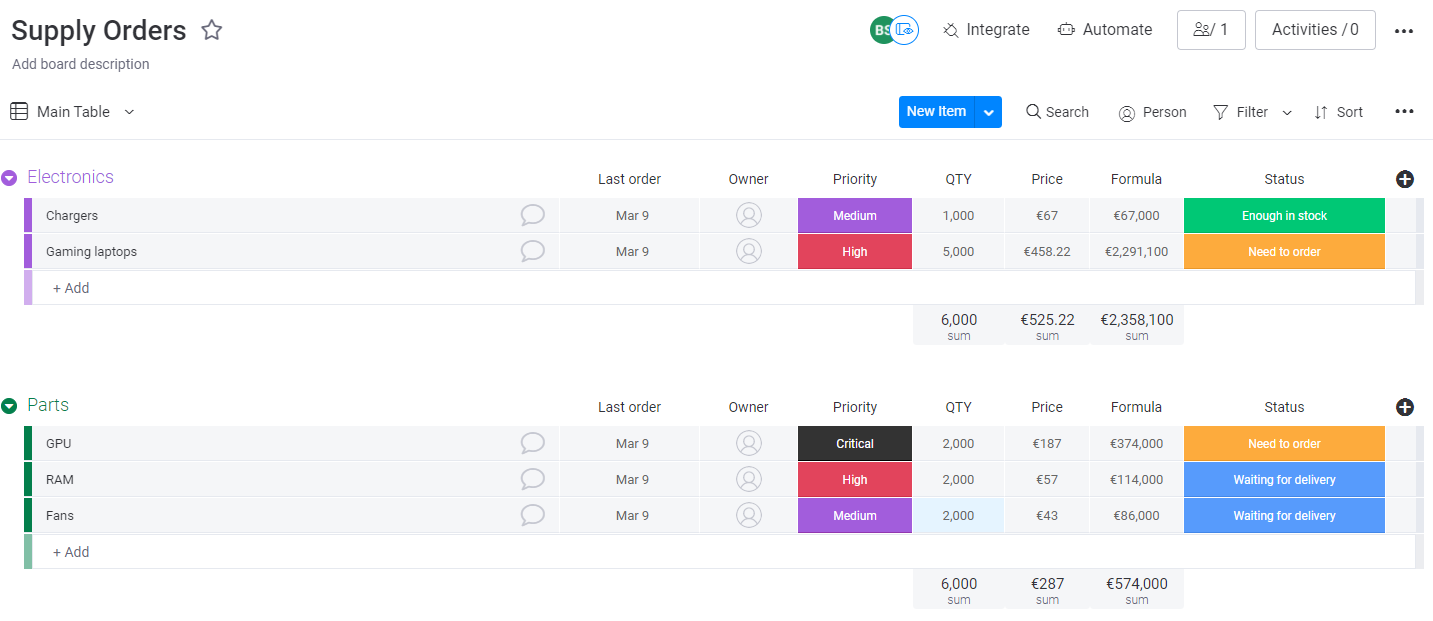
With these boards readily available, it’s easy to assess any potential cash flow or inventory issues.
Use automations and integrations to keep the right people informed at all times.
Use our 40+ native integrations and powerful automation builder to keep everyone on the same page. For example, send automatic Slack messages or emails when you exceed a due delivery date.
For B2B companies who use a bulk ordering and invoicing system, you can even set up order forms directly from monday.com.
If you use enterprise resource planning (ERP) software, you can easily build an integration using our API and 50+ pre-made adaptors.
On-time production is key to healthy customer relationships
If you can’t deliver products on time, your customers won’t be happy. It doesn’t matter if they’re resellers or end consumers — you need to keep your deadlines.
A healthy production schedule that factors in risk buffers, combined with a bare minimum stock surplus, is crucial to any manufacturing company.
Use monday.com’s ready-made manufacturing template to start taking back control of your production.

